Related Research Articles

Valletta is an administrative unit and the capital of Malta. Located on the main island, between Marsamxett Harbour to the west and the Grand Harbour to the east, its population within administrative limits in 2014 was 6,444. According to the data from 2020 by Eurostat, the Functional Urban Area and metropolitan region covered the whole island and has a population of 480,134. Valletta is the southernmost capital of Europe, and at just 0.61 square kilometres (0.24 sq mi), it is the European Union's smallest capital city.
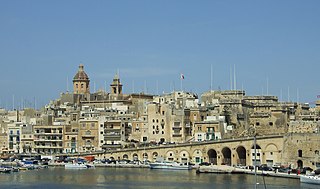
Birgu, also known by its title Città Vittoriosa, is an old fortified city on the south side of the Grand Harbour in the South Eastern Region of Malta. The city occupies a promontory of land with Fort Saint Angelo at its head and the city of Cospicua at its base. Birgu is ideally situated for safe anchorage, and over time it has developed a very long history with maritime, mercantile and military activities.

Senglea, also known by its title Città Invicta, is a fortified city in the South Eastern Region of Malta. It is one of the Three Cities in the Grand Harbour area, the other two being Cospicua and Vittoriosa, and has a population of approximately 2,720 people. The city's title Città Invicta was given because it managed to resist the Ottoman invasion at the Great Siege of Malta in 1565. The name Senglea comes from the Grand Master who built it Claude de la Sengle and gave the city a part of his name. While Senglea is the 52nd most populated locality on the island, due to its incredibly small land area, it is the 2nd most densely populated locality after Sliema.
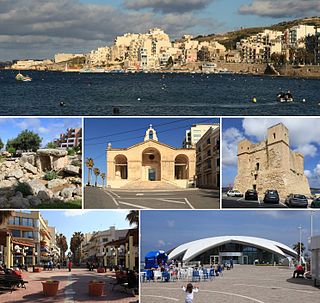
St. Paul's Bay is a town in the Northern Region of Malta, sixteen kilometres northwest of the capital Valletta. Saint Paul's Bay is the largest town in the Northern Region and the seat of the Northern Regional Committee.

St John's Co-Cathedral is a Roman Catholic co-cathedral in Valletta, Malta, dedicated to Saint John the Baptist. It was built by the Order of St. John between 1573 and 1578, having been commissioned by Grand Master Jean de la Cassière as the Conventual Church of Saint John.
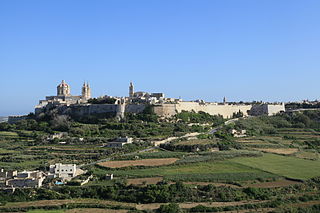
Mdina, also known by its Italian-language titles Città Vecchia and Città Notabile, is a fortified city in the Northern Region of Malta which served as the island's capital from antiquity to the medieval period. The city is still confined within its walls, and has a population of just under 300, but it is contiguous with the town of Rabat, which takes its name from the Arabic word for suburb, and has a population of over 11,000.

The Great Siege of Malta occurred in 1565 when the Ottoman Empire attempted to conquer the island of Malta, then held by the Knights Hospitaller. The siege lasted nearly four months, from 18 May to 13 September 1565.
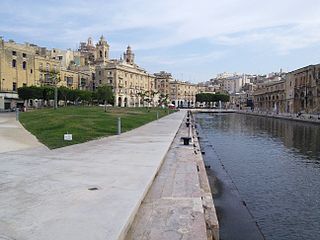
Cospicua, also known by its titles Città Cospicua or Civitas Cottonera, is a double-fortified harbour city in the South Eastern Region of Malta. Along with Birgu and Senglea, it is one of the Three Cities, located within the Grand Harbour to the east of the capital city Valletta. With a population of 5,395 as of March 2014, it is the most dense city of the Three Cities.

Naxxar is a small city in the Northern Region of Malta, with a population of 14,891 people as of March 2014. The Naxxar Church is dedicated to Our Lady of Victories. The annual village feast is celebrated on 8 September. Naxxar was formerly known for hosting the Maltese International Trade Fair at Maltese International Trade Fair Grounds.
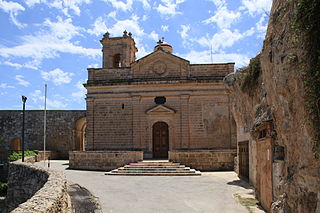
The Sanctuary of Our Lady of Mellieħa is a Roman Catholic church in the village of Mellieħa in Malta. The sanctuary originated as a natural cave which was consecrated as a church at an unknown date, and local traditions link its establishment to antiquity or the medieval period. The church's altarpiece is a Byzantine-style fresco which is believed to date back to the late 12th or early 13th centuries, and it is said to be miraculous.

Fort St. Angelo is a bastioned fort in Birgu, Malta, located at the centre of the Grand Harbour. It was originally built in the medieval period as a castle called the Castrum Maris. It was rebuilt by the Order of Saint John as a bastioned fort called Fort Saint Angelo between the 1530s and the 1560s, and it is best known for its role as the Order's headquarters during the Great Siege of Malta of 1565. A major reconstruction to designs of Carlos de Grunenbergh took place in the 1690s, giving the fort its current appearance.

Fort Saint Michael was a small fort in the land front of the city of Senglea, Malta. It was originally built in the 1552 and it played a significant role in the Great Siege of Malta of 1565. Following the siege, it was rebuilt as Saint Michael Cavalier, and it was completed in 1581. The cavalier was partially demolished in the 20th century, and only a part of its base still exists today.

Victory Day is a public holiday celebrated in Malta on 8 September and recalls the end of three historical sieges made on the Maltese archipelago, namely: the Great Siege of Malta by the Ottoman Empire ending in 1565; the Siege of Valletta by the French Blockade ending in 1800; and, the Siege of Malta during the Second World War by the Axis forces ending in 1943.

Manuel Pinto da Fonseca was a Portuguese nobleman, the 68th Grand Master of the Order of Saint John, from 1741 until his death.

Francisco Ximénez de Tejada y Eslava was a Spanish knight who served as the 69th Prince and Grand Master of the Order of Malta from 1773 to 1775. During his reign the Order became unpopular mainly due to bankruptcy brought by the lavish lifestyle of his predecessor Manuel Pinto da Fonseca. His reign was marked by the unsuccessful Rising of the Priests.

The Grandmaster's Palace, officially known as The Palace, is a palace in Valletta, Malta. It was built between the 16th and 18th centuries as the palace of the Grand Master of the Order of St. John, who ruled Malta from 1530 to 1798, and was also known as the Magisterial Palace. When the knights were expelled by Napoleonic France, it became the National Palace. During the period of British rule beginning in 1800, it was the Governor's Palace.

Hospitaller Malta, officially the Monastic State of the Order of Malta, and known within Maltese history as the Knights' Period, was a polity which existed between 1530 and 1798 when the Mediterranean islands of Malta and Gozo were ruled by the Order of St. John of Jerusalem. It was formally a vassal state of the Kingdom of Sicily, and it came into being when Emperor Charles V granted the islands as well as the city of Tripoli in modern Libya to the Order, following the latter's loss of Rhodes in 1522. Hospitaller Tripoli was lost to the Ottoman Empire in 1551, but an Ottoman attempt to take Malta in 1565 failed.

Fra' Jean "Parisot" de la Valette was a French nobleman and 49th Grand Master of the Order of Malta, from 21 August 1557 to his death in 1568. As a Knight Hospitaller, joining the order in the Langue de Provence, he fought with distinction against the Turks at Rhodes. As Grand Master, Valette became the Order's hero and most illustrious leader, commanding the resistance against the Ottomans at the Great Siege of Malta in 1565, sometimes regarded as one of the greatest sieges of all time.

The fortifications of Malta consist of a number of walled cities, citadels, forts, towers, batteries, redoubts, entrenchments and pillboxes. The fortifications were built over thousands of years, from around 1450 BC to the mid-20th century, and they are a result of the Maltese islands' strategic position and natural harbours, which have made them very desirable for various powers.

Palazzo Parisio, formerly known as Scicluna Palace, Palazzo Scicluna, and officially Palazzo Parisio and Gardens, is a 20th-century palace in Naxxar, Malta. On site was a hunting lodge built in 1733 by Paolo Parisio, and was used as a summer or permanent residence, barracks and a college, before being acquired by the Marquis Scicluna in 1898.
References
- ↑ Dictionary of Maltese Biographies Vol. 1 A-F. Pietà: Pubblikazzjonijiet Indipendenza. 2009. p. 149. ISBN 9789993291329.
- 1 2 "Toni Bajada The Maltese Messenger of the Grand Master". ilovebooks.com.mt. Retrieved 22 March 2014.
- ↑ "The Great Siege of 1565". San Andrea School . Archived from the original on 18 January 2012. Retrieved 22 March 2014.
- ↑ Sciberras, Sandro. "Theme 1: The early years of the Order's rule" (PDF). St Benedict College. Archived from the original (PDF) on 23 March 2014. Retrieved 23 March 2014.
- ↑ Bain, Carolyn (2007). Malta & Gozo. Lonely Planet Publications Pty Ltd. p. 25. ISBN 978-1741045406.